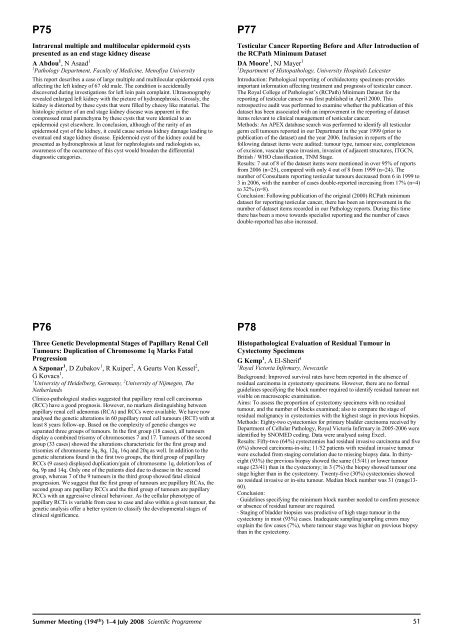2008 Summer Meeting - Leeds - The Pathological Society of Great ...
2008 Summer Meeting - Leeds - The Pathological Society of Great ...
2008 Summer Meeting - Leeds - The Pathological Society of Great ...
Create successful ePaper yourself
Turn your PDF publications into a flip-book with our unique Google optimized e-Paper software.
P75Intrarenal multiple and multilocular epidermoid cystspresented as an end stage kidney diseaseAAbdou 1 , N Asaad 11 Pathology Department, Faculty <strong>of</strong> Medicine, Men<strong>of</strong>iya UniversityThis report describes a case <strong>of</strong> large multiple and multilocular epidermoid cystsaffecting the left kidney <strong>of</strong> 67 old male. <strong>The</strong> condition is accidentallydiscovered during investigations for left loin pain complaint. Ultrasonographyrevealed enlarged left kidney with the picture <strong>of</strong> hydronephrosis. Grossly, thekidney is distorted by these cysts that were filled by cheesy like material. <strong>The</strong>histologic picture <strong>of</strong> an end stage kidney disease was apparent in thecompressed renal parenchyma by these cysts that were identical to anepidermoid cyst elsewhere. In conclusion, although <strong>of</strong> the rarity <strong>of</strong> anepidermoid cyst <strong>of</strong> the kidney, it could cause serious kidney damage leading toeventual end stage kidney disease. Epidermoid cyst <strong>of</strong> the kidney could bepresented as hydronephrosis at least for nephrologists and radiologists so,awareness <strong>of</strong> the occurrence <strong>of</strong> this cyst would broaden the differentialdiagnostic categories.P77Testicular Cancer Reporting Before and After Introduction <strong>of</strong>the RCPath Minimum DatasetDA Moore 1 ,NJ Mayer 11 Department <strong>of</strong> Histopathology, University Hospitals LeicesterIntroduction: <strong>Pathological</strong> reporting <strong>of</strong> orchidectomy specimens providesimportant information affecting treatment and prognosis <strong>of</strong> testicular cancer.<strong>The</strong> Royal College <strong>of</strong> Pathologist’s (RCPath) Minimum Dataset for thereporting <strong>of</strong> testicular cancer was first published in April 2000. Thisretrospective audit was performed to examine whether the publication <strong>of</strong> thisdataset has been associated with an improvement in the reporting <strong>of</strong> datasetitems relevant to clinical management <strong>of</strong> testicular cancer.Methods: An APEX database search was performed to identify all testiculargerm cell tumours reported in our Department in the year 1999 (prior topublication <strong>of</strong> the dataset) and the year 2006. Inclusion in reports <strong>of</strong> thefollowing dataset items were audited: tumour type, tumour size, completeness<strong>of</strong> excision, vascular space invasion, invasion <strong>of</strong> adjacent structures, ITGCN,British / WHO classification, TNM Stage.Results: 7 out <strong>of</strong> 8 <strong>of</strong> the dataset items were mentioned in over 95% <strong>of</strong> reportsfrom 2006 (n=25), compared with only 4 out <strong>of</strong> 8 from 1999 (n=24). <strong>The</strong>number <strong>of</strong> Consultants reporting testicular tumours decreased from 6 in 1999 to3 in 2006, with the number <strong>of</strong> cases double-reported increasing from 17% (n=4)to 32% (n=8).Conclusion: Following publication <strong>of</strong> the original (2000) RCPath minimumdataset for reporting testicular cancer, there has been an improvement in thenumber <strong>of</strong> dataset items recorded in our Pathology reports. During this timethere has been a move towards specialist reporting and the number <strong>of</strong> casesdouble-reported has also increased.P76Three Genetic Developmental Stages <strong>of</strong> Papillary Renal CellTumours: Duplication <strong>of</strong> Chromosome 1q Marks FatalProgressionA Szponar 1 , D Zubakov 1 ,RKuiper 2 , A Geurts Von Kessel 2 ,GKovacs 1 .1 University <strong>of</strong> Heidelberg, Germany, 2 University <strong>of</strong> Nijmegen, <strong>The</strong>NetherlandsClinico-pathological studies suggested that papillary renal cell carcinomas(RCC) have a good prognosis. However, no markers distinguishing betweenpapillary renal cell adenomas (RCA) and RCCs were available. We have nowanalysed the genetic alterations in 60 papillary renal cell tumours (RCT) with atleast 8 years follow-up. Based on the complexity <strong>of</strong> genetic changes weseparated three groups <strong>of</strong> tumours. In the first group (18 cases), all tumoursdisplay a combined trisomy <strong>of</strong> chromosomes 7 and 17. Tumours <strong>of</strong> the secondgroup (33 cases) showed the alterations characteristic for the first group andtrisomies <strong>of</strong> chromosome 3q, 8q, 12q, 16q and 20q as well. In addition to thegenetic alterations found in the first two groups, the third group <strong>of</strong> papillaryRCCs (9 cases) displayed duplication/gain <strong>of</strong> chromosome 1q, deletion/loss <strong>of</strong>6q, 9p and 14q. Only one <strong>of</strong> the patients died due to disease in the secondgroup, whereas 7 <strong>of</strong> the 9 tumours in the third group showed fatal clinicalprogression. We suggest that the first group <strong>of</strong> tumours are papillary RCAs, thesecond group are papillary RCCs and the third group <strong>of</strong> tumours are papillaryRCCs with an aggressive clinical behaviour. As the cellular phenotype <strong>of</strong>papillary RCTs is variable from case to case and also within a given tumour, thegenetic analysis <strong>of</strong>fer a better system to classify the developmental stages <strong>of</strong>clinical significance.P78Histopathological Evaluation <strong>of</strong> Residual Tumour inCystectomy SpecimensG Kemp 1 , A El-Sherif 11 Royal Victoria Infirmary, NewcastleBackground: Improved survival rates have been reported in the absence <strong>of</strong>residual carcinoma in cystectomy specimens. However, there are no formalguidelines specifying the block number required to identify residual tumour notvisible on macroscopic examination.Aims: To assess the proportion <strong>of</strong> cystectomy specimens with no residualtumour, and the number <strong>of</strong> blocks examined; also to compare the stage <strong>of</strong>residual malignancy in cystectomies with the highest stage in previous biopsies.Methods: Eighty-two cystectomies for primary bladder carcinoma received byDepartment <strong>of</strong> Cellular Pathology, Royal Victoria Infirmary in 2005-2006 wereidentified by SNOMED coding. Data were analysed using Excel.Results: Fifty-two (64%) cystectomies had residual invasive carcinoma and five(6%) showed carcinoma-in-situ; 11/52 patients with residual invasive tumourwere excluded from staging correlation due to missing biopsy data. In thirtyeight(93%) the previous biopsy showed the same (15/41) or lower tumourstage (23/41) than in the cystectomy; in 3 (7%) the biopsy showed tumour onestage higher than in the cystectomy. Twenty-five (30%) cystectomies showedno residual invasive or in-situ tumour. Median block number was 31 (range13-60).Conclusion:· Guidelines specifying the minimum block number needed to confirm presenceor absence <strong>of</strong> residual tumour are required.· Staging <strong>of</strong> bladder biopsies was predictive <strong>of</strong> high stage tumour in thecystectomy in most (93%) cases. Inadequate sampling/sampling errors mayexplain the few cases (7%), where tumour stage was higher on previous biopsythan in the cystectomy.<strong>Summer</strong> <strong>Meeting</strong> (194 th ) 1–4 July <strong>2008</strong> Scientific Programme51













